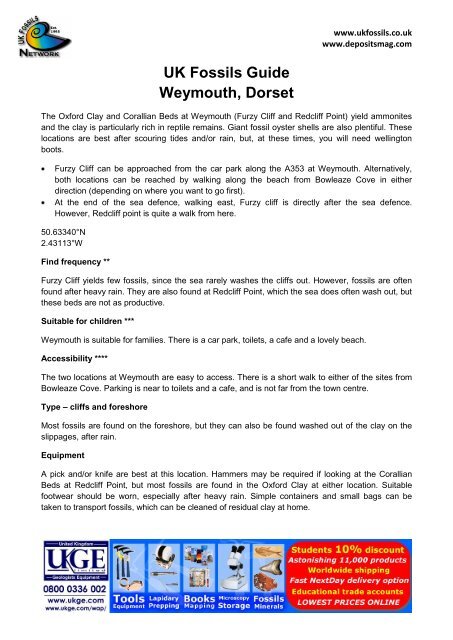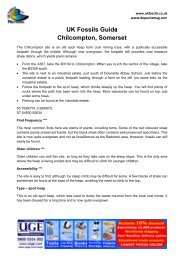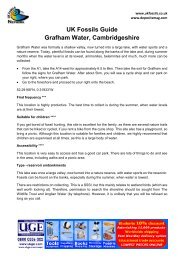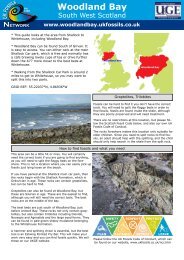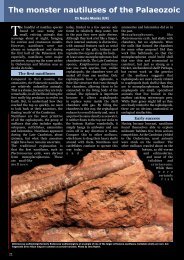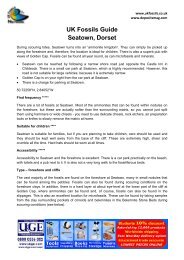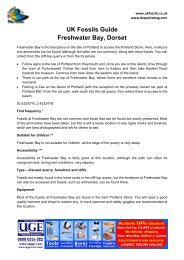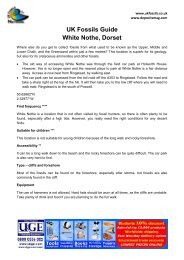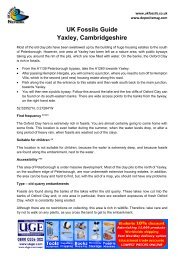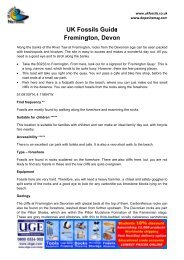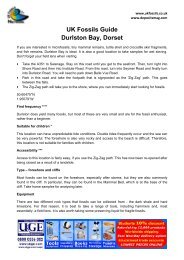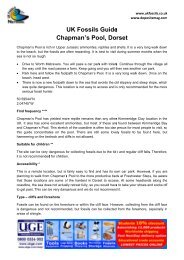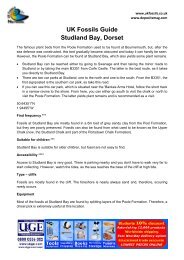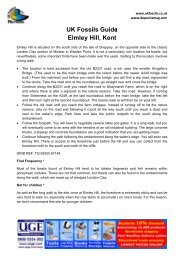Create successful ePaper yourself
Turn your PDF publications into a flip-book with our unique Google optimized e-Paper software.
www.ukfossils.co.uk<br />
www.depositsmag.com<br />
<strong>UK</strong> <strong>Fossils</strong> Guide<br />
<strong>Weymouth</strong>, Dorset<br />
The Oxford Clay and Corallian Beds at <strong>Weymouth</strong> (Furzy Cliff and Redcliff Point) yield ammonites<br />
and the clay is particularly rich in reptile remains. Giant fossil oyster shells are also plentiful. These<br />
locations are best after scouring tides and/or rain, but, at these times, you will need wellington<br />
boots.<br />
Furzy Cliff can be approached from the car park along the A353 at <strong>Weymouth</strong>. Alternatively,<br />
both locations can be reached by walking along the beach from Bowleaze Cove in either<br />
direction (depending on where you want to go first).<br />
At the end of the sea defence, walking east, Furzy cliff is directly after the sea defence.<br />
However, Redcliff point is quite a walk from here.<br />
50.63340°N<br />
2.43113°W<br />
Find frequency **<br />
Furzy Cliff yields few fossils, since the sea rarely washes the cliffs out. However, fossils are often<br />
found after heavy rain. They are also found at Redcliff Point, which the sea does often wash out, but<br />
these beds are not as productive.<br />
Suitable for children ***<br />
<strong>Weymouth</strong> is suitable for families. There is a car park, toilets, a cafe and a lovely beach.<br />
Accessibility ****<br />
The two locations at <strong>Weymouth</strong> are easy to access. There is a short walk to either of the sites from<br />
Bowleaze Cove. Parking is near to toilets and a cafe, and is not far from the town centre.<br />
Type – cliffs and foreshore<br />
Most fossils are found on the foreshore, but they can also be found washed out of the clay on the<br />
slippages, after rain.<br />
Equipment<br />
A pick and/or knife are best at this location. Hammers may be required if looking at the Corallian<br />
Beds at Redcliff Point, but most fossils are found in the Oxford Clay at either location. Suitable<br />
footwear should be worn, especially after heavy rain. Simple containers and small bags can be<br />
taken to transport fossils, which can be cleaned of residual clay at home.
www.ukfossils.co.uk<br />
www.depositsmag.com<br />
Geology<br />
At Furzy Cliff, 45m of Upper Oxford Clay is exposed. However, this tends to be badly slipped and it<br />
is very difficult to pin-point any particular beds. The cliffs are rarely washed out, so heavy rain is<br />
usually required for any chance of finding fossils.<br />
Walking further East to Redcliff Point, a full succession of Corallian Beds can be seen. In addition,<br />
the Upper Oxford Clay is well exposed here and contains pyritised ammonites from the Mariae<br />
Zone.<br />
Fossil collecting<br />
These locations are part of the Jurassic World Heritage site, so hammering or digging in the cliff is<br />
not permitted.<br />
At Fuzzy Cliff, it is best to collect fossils after heavy rain, as this often causes slippages. The sea<br />
rarely washes the cliff, but at Redcliff Point, the sea does regularly wash the cliffs, so you have a<br />
better chance of finding something at this location. At either site, search the washed clay on the<br />
foreshore or search the areas of shingle.<br />
At Furzy Cliff, the ammonite, Cardioceras, can be found along with oysters (Gryphaea dilatata and<br />
Lopha). Ichthyosaur, crocodile and crustacean remains have also been reported, but the sea rarely<br />
washes these cliffs out anymore, so collecting is best done after heavy rain.<br />
At Redcliff point, pyritised ammonites of the Mariae Zone can be found.<br />
Safety<br />
Common sense when collecting at all locations should be used and prior knowledge of tide times is<br />
essential. However, Furzy Cliff is rarely washed out by the sea and, as the sea defence is just west<br />
of the cliff, there is little danger here. However, the danger of being cut off from the tide at Redcliff<br />
Point should be noted.<br />
While we (<strong>UK</strong>GE/<strong>UK</strong> <strong>Fossils</strong>) try to ensure that the content of this location guide is accurate and up to date, we cannot and do not<br />
guarantee this. Nor can we be held liable for any loss or injury caused by or to a person visiting this site. Remember: this is only a<br />
location guide and the responsibility remains with the person or persons making the visit for their own personal safety and the safety of<br />
their possessions. That is, any visit to this location is of a personal nature and has not been arranged or directly suggested by <strong>UK</strong> <strong>Fossils</strong>.<br />
In addition, we recommend visitors get their own personal insurance cover. Please also remember to check tide times and rights of way<br />
(where relevant), and to behave in a responsible and safe manner at all times (for example, by keeping away from cliff faces and mud).


